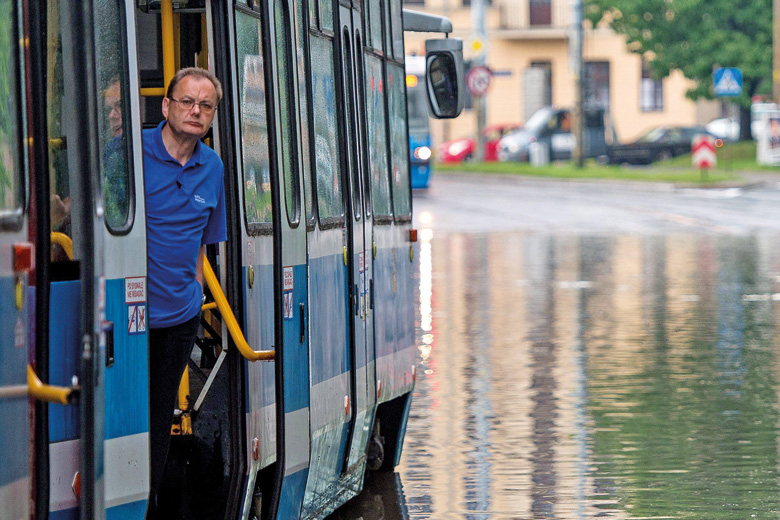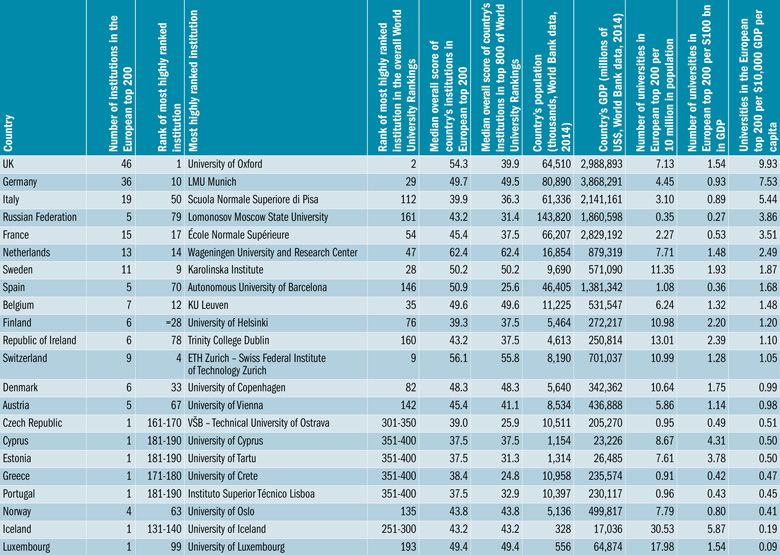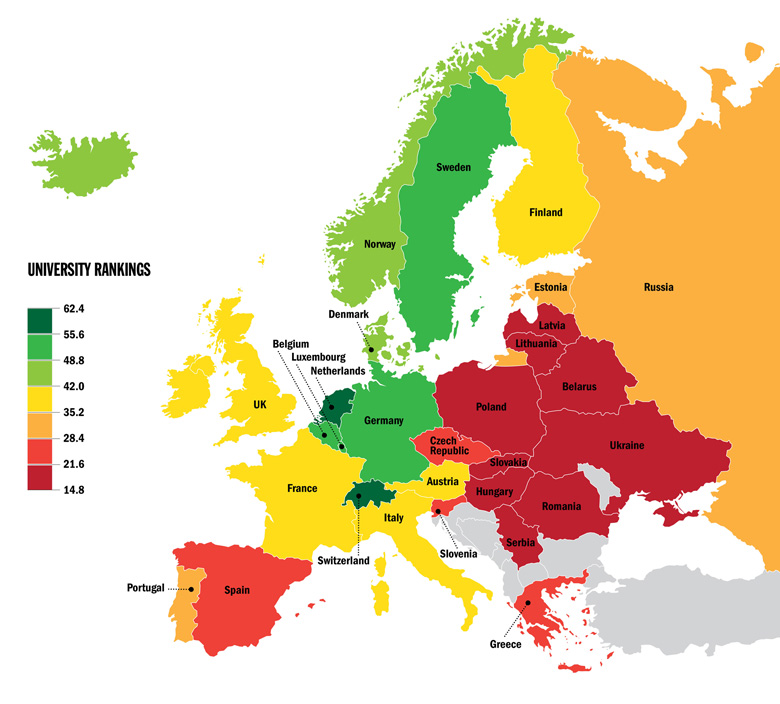View the full list of the 200 best universities in Europe
When US presidential hopeful Bernie Sanders painted a picture of the perfect model of higher education, he didn’t reference Harvard, Yale or Stanford; instead he cited universities in Germany and Scandinavia. He held up their education systems as ones that the US should ape when pledging to make tuition free at public colleges and universities last year.
“This is not a radical idea,” he wrote on his campaign website. “Last year, Germany eliminated tuition because they believed that charging students $1,300 [£894] per year was discouraging Germans from going to college...Finland, Norway, Sweden and many other countries around the world also offer free college to all of their citizens. If other countries can take this action, so can the United States of America.”
A new ranking published today by Times Higher Education lends weight to the senator’s rosy view; Germany, Finland and Sweden are among the highest-performing countries in a list of the top 200 universities in Europe. The ranking is based on the data and methodology used to compile the THE World University Rankings 2015-16. Institutions are measured on their teaching environment, research environment, citations (research influence), industry income and international outlook.
While the UK dominates the table, taking nearly a quarter of places (46), including seven of the top 10, Germany is the second most represented nation, with 36 universities, almost a third of which (11) are in the top 50. The nation’s institutions score particularly highly for their teaching environment: a measure based on reputation for teaching, as well as metrics such as income and numbers of students and doctorates per staff member. They also achieve high average scores for research citations and links with industry.
While Finland and Sweden are much smaller nations, they both punch above their weight relative to their population size and gross domestic product (GDP) (see table below). Both countries have about 11 universities in the top 200 per 10 million of the population – beating the UK, Germany and the Netherlands. Other strong performers on those measures include Denmark, the Republic of Ireland and (per head of population) Switzerland. When assessed on the number of universities in the top 200 in relation to GDP per capita, which reflects spending power, the UK and Germany rank highest.
10 best universities in Europe 2016
| Rank | Institution | Country |
| 1 | University of Oxford | UK |
| 2 | University of Cambridge | UK |
| 3 | Imperial College London | UK |
| 4 | ETH Zurich – Swiss Federal Institute of Technology Zurich | Switzerland |
| 5 | University College London (UCL) | UK |
| 6 | London School of Economics and Political Science (LSE) | UK |
| 7 | University of Edinburgh | UK |
| 8 | King’s College London | UK |
| 9 | Karolinska Institute | Sweden |
| 10 | LMU Munich | Germany |
View the full top 200 table of the best universities in Europe
“The top research universities in northwestern Europe…have considerably lifted their performance and profile at world level in the last 15 years,” says Simon Marginson, professor of international higher education at the UCL Institute of Education.
“The first international ranking systems more than a decade ago played a role by energising them to lift their performance in the face of the very strong American sector. On the whole, they have had strong support from government.”
Jussi Välimaa, professor at the Finnish Institute for Educational Research at Finland’s University of Jyväskylä, says that one reason for the country’s success is that “strong academic fields” can be found in “every Finnish university”.
“This means that every Finnish university reaches the highest international standard in one or more disciplines. Normally this translates into good academic reputation,” he says.
This excellence across the system is related to the fact that there is not a “strong institutional stratification” in the country’s higher education landscape, he adds. “It can be said that all Finnish universities are good universities – or, at least, that there are no bad universities in Finland.”
Finland’s main strength is its research influence. However, while its international outlook score is on a par with Germany’s and better than most countries in eastern and southern Europe, Finland would still appear in the bottom half of the table if ranked on internationalisation alone.
Välimaa is concerned that Finnish universities’ international outlook will further deteriorate when the country introduces tuition fees for overseas students from August 2017: “It is quite probable that Finland will follow the example of Sweden [which introduced fees for non-EU students in 2011] and lose about 80 per cent of its international students.”
Paul Benneworth, principal researcher at the Center for Higher Education Policy Studies (CHEPS) at the Netherlands’ University of Twente, also questions whether Finland’s universities will regress after funding cuts. Its research and development spending was 3.17 per cent of GDP in 2014 (compared with 1.7 per cent in the UK) but last year prime minister Juha Sipilä announced that university budgets would be cut by about €500 million (£388 million) by 2019.
“It will be interesting to see…whether you get a Blackburn Rovers-type effect, [so that] when the money is cut off, the quality of the system really goes downhill rapidly, or whether…the universities will be functioning at such a high level [that] they’ll be able to continue this level of performance with reduced public funding,” Benneworth says.
Best universities in Europe 2016: countries compared
The same question might be raised about Danish universities, given their government’s announcement in January that their funding will be cut by 6 per cent. This prompted the country’s top-performing institution, the University of Copenhagen (33rd in the European ranking), to announce plans to make 7 per cent of its workforce – more than 500 staff – redundant, about half of them academics.
For Benneworth, the country that stands out in this ranking is Germany. He cites two reasons for the nation’s success: a focus from its government on improving the quality of institutions that have been “cruising”, and the universities themselves becoming “much more savvy at playing the game” of league tables.
“There has been a conscious effort within Germany, stimulated by the league tables, and it’s reflected in their performance in the league tables,” he says, citing in particular the government’s Excellence Initiative, which has pumped huge amounts of money into a select group of top-tier institutions in recent years. But he adds that league tables still fail to represent “how strong Germany’s higher education really is”. He suggests that this is because other countries, such as Sweden, are even more aggressive at improving the aspects of their education systems that are included in rankings tables.
At the other end of the spectrum, the east and south of Europe generally score poorly in our European ranking. Countries in these regions either perform relatively weakly (Estonia, Spain, Italy, Greece and Portugal) or do not appear at all in the top 200 (Poland, Ukraine, Romania, Bulgaria and the whole of the former Yugoslavia).
Benneworth says that it is “interesting” that Estonia’s University of Tartu appears in the ranking (chalking up the country’s first appearance in the top 400 of the overall THE World University Rankings). He attributes this to the fact that Estonia is “moving into a more Western orbit”, and, in particular, forging close cultural and infrastructural links with Finland.
Just five Russian institutions make the top 200 list, making it the lowest-ranked country relative to its population and GDP, although it ranks highly relative to its GDP per capita.
Median overall score of each country’s institutions in the top 800 of the World University Rankings
Spain and Italy are also lagging behind. While Italy is the third most-represented country in the list, with 19 institutions, and does well relative to its GDP per capita, its top-ranked university, Scuola Normale Superiore di Pisa, only just lands within the top 50, and the rest are generally located outside the top 100. Spain has only five universities in the table and is the second-lowest country when ranked in relation to its GDP.
Välimaa cites the fact that academics in Russia and Spain are not “strongly present in the English-speaking international academic communities” as the main reason for their poor showing, adding that in Russia “the legacy of the Soviet Union is still felt strongly because there has never been a strong tradition of research universities in Russia”.
While the Russian government has made huge investments in the country’s top universities – its Project 5-100 is designed to provide enough federal support to help at least five Russian institutions enter the world top 100 by 2020 – Välimaa says that the funding of the “remaining almost 1,000 universities is not very good. Maintaining and establishing good universities takes resources and political consensus, and I am not sure that all Eastern European countries have been, or are, willing to do it.”
Marginson adds that “regulatory barriers” make it difficult for Spanish universities to attract and employ foreign talent, while Russia “finds it difficult to pay foreigners’ salaries at competitive rates and still leaks talent abroad”.
“A further barrier is that the research system is still partly nation-bound as in Soviet times – in some disciplines [papers in international journals] are habitually translated into Russian before being used; Russia has lamentable international publishing rates and the level of international collaboration is still disappointing despite policy attempts to lift it,” says Marginson.
“It is as if Russian science still believes that it gains maximum strategic advantage by freely accessing the ideas of others while holding back its own innovations from scrutiny. But that old Cold War strategic logic no longer works.”
In the modern era, for universities to “maximise their effectiveness”, they must “maximise engagement and cooperation so as to source ideas early – and that means being an active producer of knowledge with something to offer”.

Poland
‘Many Polish academics never move beyond their institutional starting points’
The lowly condition of science in Poland is the legacy of 25 years of decline.
After the end of Communism in 1990, Poland’s adoption of a market economy prompted the emergence of many private universities, amid lax requirements for the quality of their infrastructure and academic staff. But, at the same time, the amount of money available for research and academic salaries at public universities fell. This prolonged the emigration of Poland’s best scientists (which had previously been fuelled by the Communist government’s repression of political opposition) and meant that the sudden high demand for academic staff met with limited supply.
The situation was exacerbated by the fact that many scientists – particularly younger ones – were lured into higher-paying jobs in the private sector. Those academics who remained have adapted to the deteriorating situation, working as experts for various public and private institutions or accepting additional jobs at the new universities. These institutions, which accounted for 321 of Poland’s 453 higher education institutions in 2012-13, usually limit their activities to teaching and, with some exceptions, occupy low places in the national rankings.
Deadlines for completion of doctoral or habilitation theses were not enforced by the management even of the best universities, as everyone was aware of the poor conditions under which people were working. Academics’ engagement in research became limited. They were often reluctant to move abroad, especially for long periods, for fear that the network of contacts through which they derived additional income would unravel. This lack of contact with the mainstream of global science resulted in the progressive provincialisation of Poland’s scientific output.
As time went by, the central authorities undertook steps to redress this situation. Salaries were slightly increased and a cap was imposed on the number of additional jobs that academics could take. Research funding was also slightly increased, and mechanisms were developed to distribute it to scholars and universities on a more meritocratic basis.
But the funds do not offer sufficient stimulus for change, and the problems have not been solved. Universities are still unable to compete with the private sector on salary, and there is little competition for university positions. Those academics whose adaptation strategies have allowed them to survive more than two decades in such conditions often lack proper research experience. Domestic success rates of 10 to 15 per cent make applying for grants a less attractive option than taking on additional jobs for academics struggling with their household budgets. And many universities that treat scientific activity as marginal to their missions fail to provide financial or organisational support in preparing grant applications.
Moreover, the distribution of such grants is still deeply flawed. The selection by grant-giving agencies of experts to assess the applications is not really based on merit: only a small proportion are recruited from among the most highly ranked universities. Therefore a number of weak proposals get through.
Our research has shown that many Polish academics never move beyond their institutional starting points. It is a cause for justified concern that 70 per cent of Polish PhD students were undergraduates at the same institution, and that the same proportion of PhD graduates still work in their doctoral institution five years later.
Is the situation hopeless? Definitely not. Distribution of funds among the best PhD students and scientists, and enforcing compliance with the regulations around qualifications, would make a big difference. At the same time, it is not inaccurate to say that a generation of Polish academics has been lost through the authorities’ inappropriate approach to the management of science amid two decades of economic, social and cultural transformation.
Renata Siemienska is professor in the R. B. Zajonc Institute for Social Studies at the University of Warsaw.

Germany
‘Prospects for researchers are excellent and conditions for students in Germany are very attractive’
Until some 10 years ago, nationwide competition among German universities was not a priority on any political agenda. Germany basically relied on its relatively high academic standards in teaching and research. Its universities – almost all of them state-funded – were generally considered to be quite homogeneous in quality. Research at universities was conducted alongside that carried out by an equally strong non-university sector (namely the Max Planck, Helmholtz, Leibniz and Fraunhofer institutes).
The ageing of the German population, an emerging need for new skills in a globalised labour market and rising international competition made it clear that this state of slumber had to end. However, what followed was more than anybody had expected: university research and higher education became a focal point for public policy. Public funders have stepped up their financial commitment to the sector and introduced significant new policy measures, which have given research and higher education in Germany a genuine boost.
Backed up by a national “Pact for Higher Education” aimed at increasing teaching capacity – worth €14 billion (£10.9 billion) between 2007 and 2015 and more than €20 billion between 2016 and 2023 – the proportion of secondary school students entering German universities increased from about 29 per cent in 2000 to about 50 per cent in 2012. In addition, €2 billion was provided to further develop the quality of university teaching until the end of 2020.
The German Excellence Initiative (and related measures), aimed mainly at funding science and innovation, has had a similarly massive impact on university research. In two phases – 2006 to 2011 and 2012 to 2017 – Germany’s federal government and states have supported a select group of universities with about €4.6 billion in additional funds. For the first time, competition within disciplines and between universities was an explicit objective. Now, 10 years later, the benefits of these policies can be observed: the most competitive universities in Germany score higher in international rankings and our researchers are more internationally visible – and more successful than ever in acquiring third-party funds.
One should also mention the positive effects of this competition on university governance and legislation. Since differentiation between universities became a key element of the German higher education system, the autonomy of universities has been strengthened in state laws, allowing them to modernise and further improving their chances of success in the new competitive environment. As a university president, I dare to add that we should be brave and move further in this direction.
Adding up all these measures, Germany has experienced a growth of 134 per cent in overall expenditure on research, from about €5.3 billion in 2005 to €12.3 billion in 2013. It should be emphasised that basic research significantly benefited from this development. But recent studies indicate that innovation indicators also went up. This suggests that although the marketability of science output is often not researchers’ first priority, it comes as a logical and fruitful by-product of fundamental research. We are confident that the upcoming new Excellence Initiative – with a budget similar to its predecessor over a time frame yet to be decided – will continue to fund such cutting-edge research, as well as the careers of junior academics and the strategic development of universities.
Overall, we are experiencing a situation in which our universities can plan for the future with a greater degree of confidence. However, we would not be your typical Germans if we did not also articulate some caveats.
Especially in light of Germany’s worrisome demographic perspective, we should be really concerned about our lack of international faculty and students. The slight growth we have seen in international faculty from 9.4 per cent in 2009 to 10.6 per cent in 2014 is clearly not enough. With English more and more prevalent within academia all over Europe, including Germany, difficulties in learning German can no longer fully explain this shortfall. To improve internationalisation within German universities, we will have to do some groundwork. Our universities should start to recruit more highly qualified international students and faculty. Prospects for researchers are excellent, conditions for students in Germany are very attractive; and let me remind British readers in particular that all this comes without tuition fees!
Bernd Huber is president of LMU Munich.

Italy
‘The direction of Italian higher education policy makes it unlikely that the position of the country’s universities in world rankings will improve in the coming years’
Italy’s 19 institutions in the European top 200 is a reasonable number, but its premier institution, the Scuola Normale Superiore di Pisa, is only 50th. And if we look at Italy’s performance relative to GDP and population, it scores relatively low by Western European standards. Its 3.1 universities in the top 200 per 10 million in the population and 0.9 per $100 billion in GDP compare with figures of 7.1 and 1.5 respectively for the UK – a comparable country in terms of population and GDP.
At first glance, this result is disappointing. However, if we consider that the budget of the Italian higher education system in 2014 was only €13 billion (£9 billion), compared with the £30 billion spent on the UK system in 2013-14, the picture is more encouraging. A first consequence of this imbalance is a very different overall staff-to-student ratio: while there are fewer than 20 students per academic staff member in the UK (and the figure is declining), there are about 30 students per academic in Italy overall. And there are more than 20 students per academic in almost all individual Italian institutions, compared with about, or below, 10 students per staff member for the “world-class universities” in the top 10 of the European rankings.
The exceptions are the Scuola Normale Superiore di Pisa and the Scuola Superiore Sant’Anna: two institutions specialising in postgraduate training and enrolling just a few hundred students (half of them in PhD programmes). As a result, their scores for teaching are, respectively, 54.2 and 42.5, compared with an average of 26.9 for the other top 200 Italian universities, all of which are institutions offering a wide range of subjects with between 14,000 and 110,000 students.
Whatever the official pronouncements, the recent actions of Italian policymakers do not seem to be aimed at improving the rankings of Italian universities. First, academic staffing levels in Italian institutions have been swiftly declining and ageing since the beginning of the financial crisis in 2008. This is due to tightened government regulation imposed on the replacement of academic staff. Between 2009 and 2011, universities were permitted to replace only 50 per cent of staff who left or retired. That figure fell to 20 per cent in 2012, before rising again to 50 per cent in 2014. It will rise to 60 per cent in 2016 and 80 per cent in 2017, before finally being restored to 100 per cent in 2018. This policy is de facto preventing young scholars from accessing a career in Italian academia, furthering the brain drain of Italian researchers and generational inequalities within the Italian system.
Once again, the comparison with the UK is astonishing. Between 2008-09 and 2014-15, the numbers of full-time-equivalent academic staff increased by 13 per cent in the UK, compared with a drop of 12.4 per cent in Italy. Overall numbers in 2014-15 were 133,000 and 55,000, respectively. The same considerations apply to PhD students, whose number in Italy also declined by nearly 13 per cent over the same period.
Another point to consider is the recent decision of Italian policymakers to distribute public funding to universities via a new “standard cost per student” formula. This is promoting a fairer system of allocation, rather than concentrating available financial resources into a few top universities.
In short, the direction of Italian higher education policy makes it unlikely that the position of the country’s universities in world rankings will improve in the coming years. In this context, it would be of interest to evaluate how Italy scores against other countries with respect to their available budget. Probably, in an “efficiency” ranking, taking account of the financial inputs available at system level, Italy would perform significantly better.
Davide Donina is a PhD candidate in the department of economics and management at the University of Pavia. Michele Meoli is an assistant professor and Stefano Paleari is a full professor in the department of management, information and production engineering at the University of Bergamo. Paleari is also the former rector of Bergamo. They are all members of the Higher Education Research for Italy (HERe4I) group in the Cisalpino Institute for Comparative Studies in Europe at Bergamo.

Ukraine
‘On the one hand, staff are nostalgic for everything Soviet. On the other hand, the government is committed to pursuing membership of the EU’
Ukraine’s education system can be likened to Buridan’s ass, which supposedly starved to death because it could not decide which of two equidistant piles of hay to eat. On the one hand, staff are nostalgic for everything Soviet. On the other hand, the government imposes Europe’s Bologna Declaration and is committed to pursuing membership of the European Union.
Even Ukraine’s grading system is a mess: a hybrid of the old Soviet “five points” system (ranging from “unsatisfactory” to “excellent”), grade point average and the Western letter (A-E) scale. Language of instruction and scholarship is another controversial issue: Ukrainian and Russian remain dominant despite universities’ claims to be partially switching to English.
The Ukrainian government’s much-heralded process of “lustration”, which is supposed to sweep from public office former Communist Party bosses, KGB operatives and Soviet bureaucrats, has had no effect on higher education leadership.
Soviet-era academic leaders are not even familiar with what constitutes a modern university, let alone a world-class research university. Based on narrow specialisation and affiliation to the relevant ministry, Ukrainian universities are more akin to commercial and vocational schools, reliant on block grants from the state. They have no incentives for change – despite the unfavourable demographic trends that threaten the future of their institutions.
Meanwhile, academics are demotivated, both financially and professionally. The average monthly pay of an associate professor in Ukraine was $450 (£315) under the previous regime, and is now just $150. The combination of such African-level salaries with European-level prices would make recruiting talent on the world market impossible, even if administrations saw the merit in trying. It also makes involvement in corruption, in most Ukrainian academics’ eyes, a moral entitlement. Colleges are converted into family enterprises, where rectors enjoy a monopoly on authority; it is astonishing to see how theories about corrupt hierarchical structures fit the reality on the ground so precisely. Faculty members retain their positions until their deaths, surrounding themselves with their spouses, children and other relations. The president of Ukraine’s National Academy of Sciences, Borys Paton, is 97, and has ruled the institution since 1962.
The hybrid war in eastern Ukraine – a mix of civil confrontation and Russian invasion – has delivered yet another powerful blow to the country’s ailing system of higher education. Colleges based in the self-proclaimed Donetsk and Luhansk People’s Republics are a disaster. This is no surprise, since Ukraine’s academic elites have never heard of crisis management. The only institution that has genuinely attempted to relocate is the Donetsk National University, which claims up to 70 per cent of its faculty have moved to the Vinnytsia region, far away from Donetsk. All other colleges in the rebel-held areas have contented themselves with merely changing their official addresses. They offer online distance education, but have, in reality, become diploma mills, riddled with fraud.
The new, Western-leaning political regime is seeking credibility and so is involving reputable external players. For the education sector, it has invited in the Organisation for Economic Cooperation and Development: a mostly rich countries’ club that is not familiar with the current situation in the country. But before the country is offered advice or technical assistance, it needs to be given a diagnosis. And the diagnosis for the malaise in Ukraine’s higher education sector is Stalinism fused with overwhelming corruption. Until this cancerous tumour is surgically removed and Ukraine breaks away from its Soviet past, no attempts at reform will prevent its higher education sector from going the way of Buridan’s ass.
Ararat L. Osipian holds a PhD from the department of leadership, policy and organizations at Peabody College, Vanderbilt University in the US. He was previously an associate professor of economics at Bukovyna State University of Finance and Economics in Ukraine.

Sweden
‘Swedish research policy has been subject to relatively light control, and the sector has generally been left to make its own strategic choices’
The fact that 11 of Sweden’s 14 public-sector universities are in Times Higher Education’s European top 200 speaks volumes for the effectiveness of the country’s higher education system.
For a non-anglophone country, Sweden has a high level of English language skills, particularly in academia. This is an advantage when it comes to publishing in international journals and attending international conferences. But there is much more to Sweden’s success than this.
The statutory mission of Swedish higher education institutions – which also encompass 17 public-sector university colleges – is to provide education based on an academic or artistic foundation, combined with practical knowledge. There is a close connection between education and research, which are often conducted under the same roof. Swedish universities are also obliged to contribute to their surrounding communities and ensure practical benefits are derived from their research.
Students do not make any direct financial contribution to the system: tuition is free for all domestic and most European students. Hence, 85 per cent of funding for Swedish higher education – a high figure by international standards – comes from the public purse. The Swedish government also appoints vice-chancellors and lays down directives for each higher education institution in annual service agreements. However, within these parameters, the institutions are relatively free to determine their own organisational structures, allocation of resources and courses offered.
Historically, Swedish research policy has been subject to relatively light control, and the sector has generally been left to make its own strategic choices. These choices have included extensive cooperation between institutions, including the use of joint research facilities. This maximises the impact of public investment and contrasts with the hyper-competition seen in some university systems.
Academic governance and collegial decision-making structures are relatively strong in Sweden. There is also a relatively non-hierarchical relationship between different teaching and research positions. Students have a strong influence, which not only promotes quality in undergraduate education, but also has a positive impact on research. The vast majority of research students are employees and members of the academic community. This contributes to innovative thinking.
In 2013, the revenues of Swedish higher education institutions totalled 62.8 billion kronor (£5.1 billion). Undergraduate and master’s courses accounted for only 44 per cent of this, while doctoral study and research made up just over half. This is emblematic of the emphasis within the Swedish system on research.
Block funding for doctoral courses and research is specified in universities’ annual service agreements, and researchers can also apply for competitive grants from the Swedish research council. In addition, many higher education institutions receive external funding from foundations, local governments, county councils and the private sector.
A key aspect of the Swedish system is the close cooperation that exists between Swedish universities and industry, such as mobile phone company Ericsson, pharmaceutical firm AstraZeneca, food packaging icon Tetra Pak, chemical company Alfa Laval, power firm ABB and automotive manufacturers Volvo and Saab Group.
But Sweden has an equally strong tradition of government-funded basic research, and there is a strong national and political belief in expertise and research. This means that research initiatives continue to be funded throughout fluctuations in the economic climate. During the most recent economic crisis, for instance, no research funding was withdrawn. However, universities have come increasingly to depend on external funding over the past decade. If there is any cloud on the horizon for Swedish universities, it is that it is becoming ever harder to maintain a balance between applied and basic research.
Torbjörn von Schantz is vice-chancellor of Lund University. This article draws on information published by the Swedish Higher Education Authority.
POSTSCRIPT:
Print headline: The state of Europe
Register to continue
Why register?
- Registration is free and only takes a moment
- Once registered, you can read 3 articles a month
- Sign up for our newsletter
Subscribe
Or subscribe for unlimited access to:
- Unlimited access to news, views, insights & reviews
- Digital editions
- Digital access to THE’s university and college rankings analysis
Already registered or a current subscriber? Login






